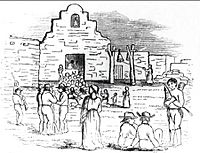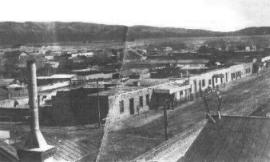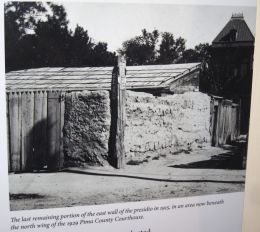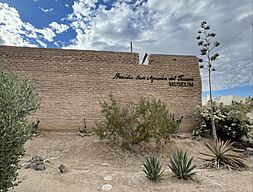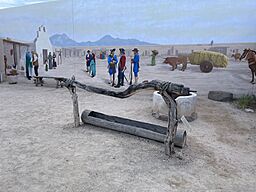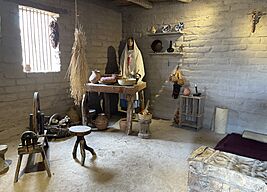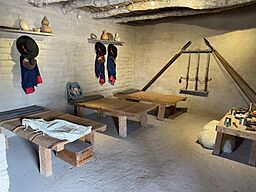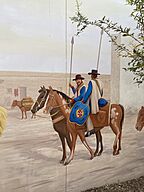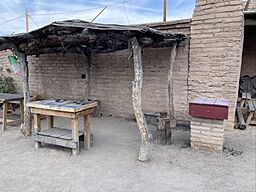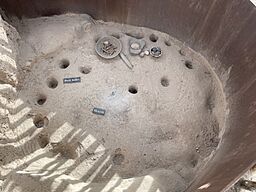Presidio San Agustín del Tucsón facts for kids
Quick facts for kids Tucson Presidio |
|
|---|---|
| Tucson, Arizona, United States | |
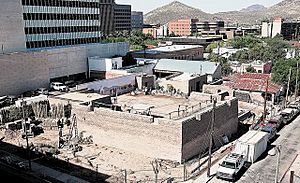
The reconstructed northeastern bastion of the Tucson Presidio in 2009
|
|
| Type | Army fortification |
| Site information | |
| Controlled by | |
| Condition | tourist attraction |
| Site history | |
| Built | 1775–1783 |
| Built by | |
| In use | 1776–1886 |
| Materials | Adobe, mesquite, earth |
| Battles/wars | Apache–Mexico Wars |
| Garrison information | |
| Past commanders |
|
| Occupants | |
The Presidio San Agustín del Tucsón was an old fort built by the Spanish in Tucson, Arizona. It was the very first building that helped start the city of Tucson in the 1700s. After Americans arrived in 1846, the fort's walls were taken down. The last part was removed in 1918. Today, a part of the fort's northeast corner has been rebuilt. It was finished in 2007 after archaeologists found the original tower.
Contents
History of the Tucson Presidio
The Spanish Period (1775-1821)
Spanish soldiers, led by Captain Hugh O'Conor, chose the spot for the Presidio San Agustin del Tucson on August 20, 1775. This spot was a high area looking over the Santa Cruz River. Nearby was an O'odham village called Cuk Ṣon. This name means "black base," referring to Sentinel Peak.
The next year, soldiers from another fort, Tubac Presidio, started building the Tucson fort. At first, it was just a few buildings inside a wooden fence. Money problems slowed down the building of strong adobe (mud brick) walls. But after a dangerous attack by Apache warriors in 1782, they quickly finished the fort by May 1783.
The fort was a large square, about 670 feet (200 meters) on each side. It had square towers at two corners. The main gate was on the west side. Inside, there was a chapel, the commander's house, and other buildings for homes and supplies. The thick adobe walls needed constant repair, especially when attacks were expected. The fort stayed mostly complete until 1856. After that, it was slowly taken apart, with the last piece removed in 1918.
Tucson grew under Spanish rule, but its population stayed small for a long time. The fort and its soldiers helped protect the area. They went on trips to fight different Native American groups, especially the Apache. These trips helped keep the area safe from raids on Spanish homes and farms. Other groups, like the Pimas, were mostly peaceful and sometimes even helped the Spanish soldiers as scouts.
Other Spanish forts in the area, like Presidio Santa Cruz de Terrenate, were built but later abandoned because of Apache attacks. Even though the Spanish had fewer soldiers, they managed to hold onto most of their settlements. But they could not completely stop the Native American raids. In 1821, the Spanish period ended, and Tucson became a Mexican town.
The Mexican Period (1821-1856)
When Mexico became independent from Spain in 1821, the Tucson Presidio was still a Spanish fort. The soldiers there accepted Mexico's freedom. Unlike some other Spanish settlements, Tucson remained inhabited. During the Mexican period, many of Tucson's people were Native Americans.
After gaining independence, Mexico faced hard times. The forts on the frontier, like Tucson, did not get enough supplies or soldiers. Old friendships between Spain and some Native American groups ended. The Apache remained a big threat. Many Spanish settlements in Arizona and New Mexico were abandoned, and people moved south.
Tucson, along with a few mission towns like San Xavier, managed to survive. Apaches continued to raid and fight with Mexican soldiers right outside the Presidio walls. They stole livestock, just as they had from the Spanish. The Mexican government had less money and fewer soldiers to defend the area.
By 1846, when the Mexican–American War began, Mexico's economy was better. The Tucson Presidio had about 200 soldiers and two cannons. As the United States Army's Mormon Battalion marched through Arizona, they came close to fighting the Mexican army at the fort. The American soldiers were on their way to California. The Mormon forces captured the presidio after the Mexican commander decided not to fight. He moved his soldiers to other towns.
The war ended with the United States winning. In 1848, Mexico sold a large area, including Tucson, to the U.S. This was called the Mexican Cession. Tucson became part of the American New Mexico Territory after the Gadsden Purchase in 1853. Even though the land was bought, the Mexican soldiers did not leave the Tucson Presidio until March 1856. Most Mexican residents stayed in Tucson.
The American Period (1856-1886)
The United States Army took control of the Tucson Presidio in 1856. The city then began to grow quickly. Famous military leaders, gold seekers, and even outlaws became part of Tucson's story. People discovered valuable minerals, leading to mining towns around Tucson. From 1870 onwards, many of Arizona's towns and cities were built.
However, hostile Native Americans remained a problem until the late 1880s. The Apache Wars began, especially with the Chiricahua Apache led by chiefs like Mangas Coloradas, Cochise, and Geronimo. They fought a guerrilla war against the new American settlements. These lands were considered traditional Apache lands. The wars continued until 1886.
The war against the Chiricahua began in 1860. Apache groups formed alliances and started fighting to remove white settlers and Mexicans from their lands. Attacks happened in southeastern Arizona and southwestern New Mexico. Hundreds of settlers were killed. Tucson was again in danger of attack. Apaches controlled the mountains around Tucson, especially after U.S. troops left in 1861.
When the American Civil War started, all the forts protecting Tucson were abandoned. This left Tucson with no military support against the Apache. Settlers in southern New Mexico Territory wanted to create their own territory. The Confederate States of America agreed and created Confederate Arizona Territory.
Apache attacks increased. Fort Tubac was attacked in August 1861 and abandoned. Survivors went to Tucson and then to Mesilla, New Mexico. Many became soldiers in the Arizona Rangers. In April 1862, Confederate soldiers under Captain Sherod Hunter arrived in Tucson. They raised the Confederate flag on May 1. This arrival may have stopped a major Apache attack on Tucson.
Captain Hunter had few men. He tried to make friends with the Pima people. He also watched for the California Column, a Union army moving into Arizona. Hunter sent groups to burn Union supplies stored at mail stations along the trail. Rebels fought the Battle of Picacho Pass north of Tucson, which delayed the Union army.
Finally, Union troops captured Fort Breckenridge and advanced on Tucson. Captain Hunter, with only about 100 men, left Tucson because he had no reinforcements. Union forces captured Tucson without a fight on May 20, 1862. General James H. Carleton and his 2,000 men took control of the presidio. The Confederates escaped.
In 1863, the Union Arizona Territory was created, and Tucson became its capital. After the Civil War, the fort was no longer used for fighting. However, its walls still offered safety to settlers until Geronimo surrendered in 1886. Fort Lowell was built near Tucson in 1873 and became a major army base. With the end of the Apache threat, the Tucson area became peaceful, and the old fort was no longer needed.
By the time of the Mexican Revolution in 1910, only one part of the old presidio walls was still standing. The rest had been buried or torn down for new buildings. This last wall was three feet thick and a few feet tall. It was finally destroyed in 1918. Later, a plaque was placed to mark its location.
In 1954, archaeologists found a part of the fort's northeastern tower. They also found an ancient Hohokam pit house underneath the presidio. More archaeological work happened between 2001 and 2006. After this, the northeastern corner of the fort was rebuilt as a museum. It opened in 2007.
Museum Highlights
Today, the Presidio San Agustin del Tucson Museum (www.TucsonPresidio.com) offers many activities. You can experience "Living History Days," attend cultural events, and take walking tours of Downtown Tucson. Other parts of the original Presidio wall are marked in the Old Pima County Courthouse courtyard and around Downtown Tucson.
See also
 In Spanish: Presidio Real de San Agustín del Tucsón para niños
In Spanish: Presidio Real de San Agustín del Tucsón para niños



